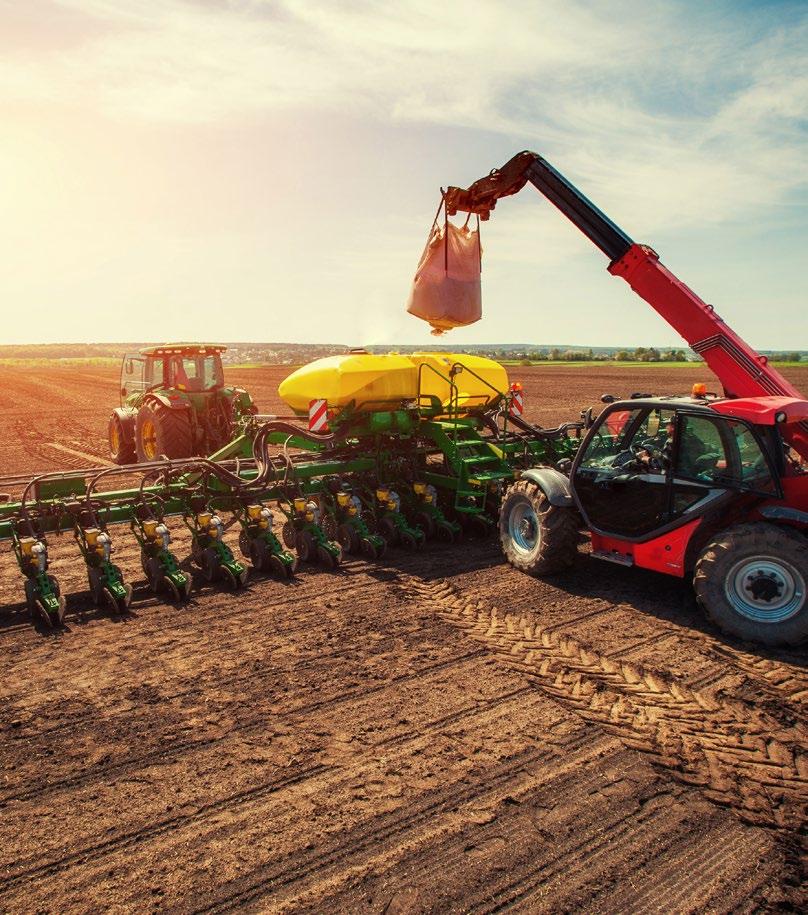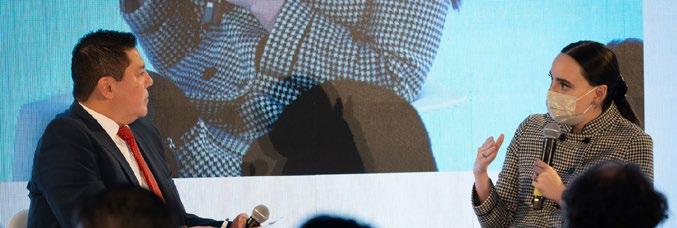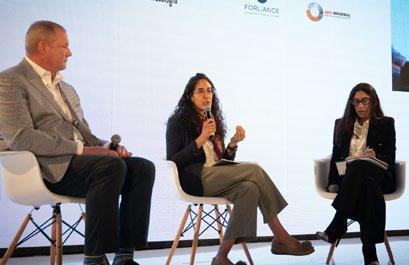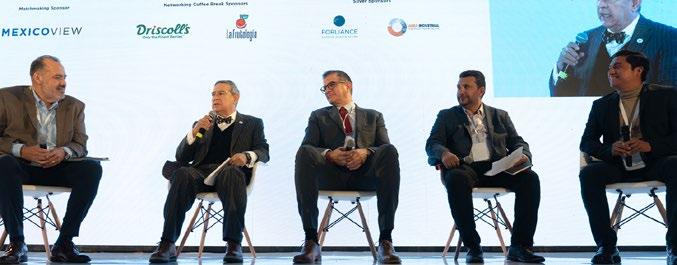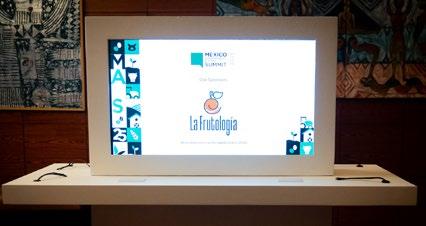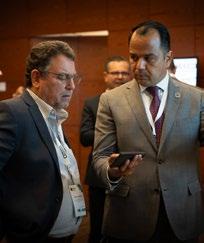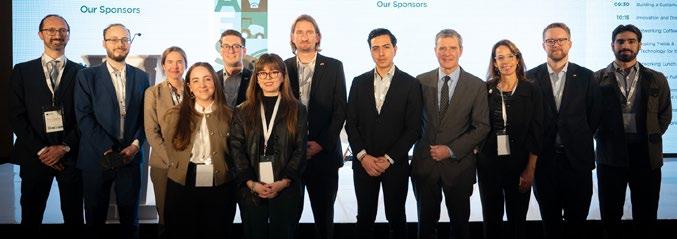Matchmaking
Mexico’s leading B2B conference organizer uses a customized app to deliver an unparalleled experience
The MBE App delivered AI-powered intent-based matchmaking to Mexico Agribusiness and Food Summit 2025 attendees
MBE App Impact
208 participants
1413 matchmaking communications
1:1 meetings conducted
25 speakers
1st Edition
4 sponsors
10,158 visits to the conference website
Conference social media impact Pre-conference social media impact
1,868 direct impressions during MAFS 72,325 direct pre-conference LinkedIn impressions
37% click through rate during MAFS 3% pre-conference click through rate 33.7% conference engagement rate
• AB Estudio de comunicación
• AgroFresh
• Allergen Free México
• Amhpac
• Amsac
• Aneberries
• Anetif
• Aphym
• A r EA INDUST r IAL ENGINEE r ING pro JECT MANAGEMENT
• ArGo -EFESo
• Arizona Fresh
• Aspros
• Badillos papas
• B anca Mifel
• BBVA
• Becerril, Coca & Becerril
• Birdie
• Blooms
• Bpifrance
• British Embassy
• Business France - French Embassy
• Cámara Española De Comercio En México
• Cámara Verde
• Camexa
• C ANACINTr A
• CANACINTr A EDo MEX
• Canami
• CanCham
• CFE
• Cimmyt
• Clg Logístico
• CNBiogás
• Colds
• Co MCE
• Co MCE SU r
• Comecarne
• Committee on Sustainability Assessment
• Company name
• Confederación Nacional De productores De papa De La república Mexicana (Conpapa)
• Consejo Mexicano de la Carne
• Consejos Agroalimentarios De México
• Consorcio Económico Agroindustrial
• Corpo Citrik
• Delegación De La Unión Europea
• Delegación General de Québec en México
• Delegación De La Unión Europea En México
• Delegation of The European Union To Mexico
• Driscolls
• Dubai Chambers
• El Agroanalista
• Embajada De Alemania
• Embajada de Canada
• Embajada de Canadá - Gobierno de o ntario
• Embajada De Corea
• Embajada de Dinamarca en México
• Embajada De España En México
• Embajada de Francia
• Embajada de Hungría
• Embajada De Italia
• Embajada De La república Checa En México
• Embassy of Denmark in Mexico
• Empacadora San Marcos Sa Cv
• Enestas
• Fira - Banco De México
• FoCA SYSTEMS
• Formula C
• Fresh mex
• Fun Fruit / The Nut House
• Gestell
• Gisena Labs
• Giz-Eu
• Global Agrotrade Advisors
• GLo BALG.A. p
• Gobierno de Alberta en Mexico
• Gobierno Del Estado De México
• Green Chamber México
• G rupo Bimbo
• G rupo CIITA
• G rupo Nauta
• Gs1 México
• Harinas SA
• Harvcrest Capital
• Haskell
• Haygrove Tunnels
• Heineken México
• Holland House Mexico
• Howden
• Iaura Group/Arizona Fresh
• IDB Invest
• IFC - International Finance Corporation
• Ifema Madrid
• IFEMA Madrid (Institución Ferial De Madrid)
• IFpA
• Lica, representación México
• Ilcereales
• Industrias rochin
• International Sos México Emergency Services
• Investhk
• I pADE Business School
• Irish Embassy
• Israel Embassy
• Karma Verde Fresh
• KoTr A-Embassy of the repúblic a of Korea
• La Moderna
• La morita farms
• La Morita Farms
• Lexington Capital
• LLYC (Llorente y Cuenca)
• M astercard
• Mercy Corps Ventures
• Ministerio de Agricultura de Alberta/ Embajada De Canadá
• Ministry of Agriculture
• Monarch Global Strategies
• Netherlands Embassy in Mexico
• Nosotrxs - Mycelium
• oCA Global
• o kko Súper Foods
• o rthodox Union Kosher
• peterson projects And Solutions Mexico
• plásticos Y E xtrusiones
• pro Chile
• proChile México
• produce pay
• pro M pErÚ en México
• QUArTUX
• rainforest Alliance
• red Ambiental
• ridder Group
• ridder Growing Solutions De Mexico
• roCHIN poSTHArVEST INN oVATIo N
• Secretaría De Agricultura
• Secretaría de Agricultura y Desarrollo rural
• SED ECo EDo MEX
• Serna pr / Heineken
• Siembra
• Siemens
• Sigma Alimentos
• Solensa
• Solo para Freir
• South pole
• Sucro Can Sourcing
• Sunfast Logistics
• Svensson
• Techo México
• Tecnologías Agribest S. A. De C.V.
• Texas-European Chamber of Commerce
• The Haskell Company
• Universidad panamericana
• Verqor
• Viamex
• WLp
• Wotian Business Group
• Xaxtla, Edlu
• Yara
WEDNESDAY, F EBRUARY 19
08:30 MEXICAN CORN: CULTIVATING HERITAGE AND NOURISHING THE FUTURE
Speaker: Altagracia Gómez, Grupo Minsa
09:00 THE FUTURE OF MEXICO’S AGRIBUSINESS & FOOD INDUSTRY
Speaker: Bram Govaerts, CIMMYT
09:30 BUILDING A SUSTAINABLE FOOD SYSTEM
Moderator: Esteban Silva, Cervecería de Colima
Panelists: Miguel Ángel Curiel, Driscoll’s
Diego Montenegro, Inter-American Institute for Cooperation on Agriculture (IICA)
Miguel Esquivel, HEINEKEN Mexico
David Hernández, Grupo Bimbo
10:15 INNOVATION AND DISRUPTION IN THE FOOD SUPPLY CHAIN
Moderator: Sandra Gómez, ArGo-EFESo
Panelists: Greg Janzow, The Haskell Company
Cecilia Valdés, Yara
12:00 BOOSTING YIELDS & SUSTAINABILITY: EQUIPMENT & TECHNOLOGY FOR THE FUTURE OF FARMING
Moderator: Isai Mendoza, Grupo Inders
Panelists: Rubén Soto, ridder Group
Nisshin Gastelum, rivulis Irrigation
Francisco X. Valdés, AmphiBIo Technologies
Leo Lobato, Karma Verde Fresh
12:00 INVESTING IN THE FUTURE OF MEXICAN AGRICULTURE
Moderator: Carlos Rodríguez, FIrA
Panelists: Hugo Garduño, Verqor
Francisco Meré, BLooMS
José Masjuan, IFC - International Finance Corporation
12:00 PRIORITIES OF MEXICO’S BUSINESS LEADERS IN AGRICULTURE AND FOOD
Moderator: César Silerio, Agroindustrias MX and Green Chamber
Panelists: Alfredo Díaz, Mexican Association for protected Horticulture (AMHpAC)
Esteban Jaramillo, CANAMI
Gildardo González, CoNpApA
Mauricio García, Consejo Mexicano de la Carne (CoMECArNE)
Luis Alberto Monarres, Mexican pork Exporters Association
ADVANCING MEXICO’S AGRIBUSINESS WITH INCLUSION, SUSTAINABILITY
The agribusiness sector remains a key driver of economic and social development in Mexico. By fostering innovation, enhancing sustainability, and improving regional integration, the country aims to build a more resilient and competitive food system, explains Altagracia Gómez, p resident, Grupo Minsa.
“The agricultural sector in Mexico is a key pillar of employment and economic activity, supporting hundreds of thousands of jobs and businesses,” said Gómez at Mexico Agribusiness & Food Summit 2025.
North America’s integrated agricultural market has demonstrated resilience, maintaining food supply stability even during the CoVID-19 pandemic and ongoing geopolitical disruptions such as the conflict between r ussia and Ukraine, explained Gómez. To maintain this status quo, p lan México, a government initiative designed to bolster key economic sectors and attract foreign investment, identifies strategic objectives aimed at strengthening the sector. These include increasing agricultural financing by MX$30 billion (US$1.5 billion), expanding cold chain logistics, and promoting cooperatives focused on packaging, processing, and exports. o ne of the key initiatives is enhancing the designation of origin for Mexican agricultural products, leveraging their unique qualities to boost value and market competitiveness.
o ne such product is corn, a cornerstone of Mexico’s economy and culture, playing a vital role in both the nation’s diet and its agricultural sector, according to Gómez. Around 90% of Mexicans include corn as part of their basic diet. “In fact, the tortilla, a staple food for millions, provides 58% of the calories consumed by Mexico’s most vulnerable populations,” she said. The grain is also a significant source of fiber, protein, and carbohydrates, reinforcing its importance in the country’s food security and nutrition.
Efforts to improve sustainability in agriculture have also become a priority, placing emphasis on irrigation technology and regional agricultural development, ensuring that production growth aligns with environmental preservation. “The agro-industry uses 89% of the available water for consumption. There is a specific program focused on the human right to access water, as well as on the modernization of irrigation systems for a more sustainable approach to agriculture,” says Gómez.
The industry spans various regions, each with distinct agricultural practices and challenges. While the north benefits from advanced irrigation and higher yields, production in the south remains significantly lower, at just 2t/ha. “The northern region is technologically advanced, while the south still faces challenges. However, there is available water, labor, and land to support
further development,” said Esteban Jaramillo, president, National Chamber of Industrialized Corn (CANAMI).
Infrastructure development plays a central role in Mexico’s economic strategy, particularly in the southern region, where investment in logistics and transportation is expected to drive growth. The Interoceanic Corridor, which will establish a railway link between the pacific and the Gulf of Mexico, is designed to reduce costs and improve access to essential goods. once fully operational, the corridor could also stimulate industrialization,
positioning the Gulf as a strategic trade gateway to the United States.
Addressing social challenges is another priority for Mexico. The government has set a target to significantly reduce food poverty, with an emphasis on supporting agricultural workers, particularly women over 60. p rograms coordinated by the Ministry of Agriculture and r ural Development (SADEr), alongside the Ministry of Welfare, aim to integrate workers into formal labor regulations, improving their conditions and access to social benefits.
THE FUTURE OF MEXICO’S AGRIBUSINESS AND FOO D INDUSTRY
The future of global food security is increasingly uncertain, subject to climate change, biodiversity loss, and shifting agricultural demands. There is an urgent need for investment in agricultural innovation and a long-term strategy to build resilient food systems, according to Bram Govaerts, General Director, CIMMYT.
CIMMYT has played a pivotal role in introducing the dwarfing gene that revolutionized wheat yields, preventing global food shortages for decades. However, ensuring future food security requires continuous investment. The emergence of crop diseases, such as UG99, a wheat disease with no natural immunity, demonstrates the need for ongoing research. “What we take for granted today must be carefully considered,” he warned. ““Seventy percent of wheat varieties worldwide originate from CIMMYT’s genetic materials. However, we cannot assume that research will continue unless we invest in it.”
“Seventy percent of wheat varieties worldwide originate from CIMMYT’s genetic materials. However, we cannot assume that research will continue unless we invest in it”
Bram Govaerts Director General | Centro Internacional de Mejoramiento de Maíz y Trigo (CIMMYT)
Since his inauguration, p resident Donald Trump signed an executive order suspending USAID’s humanitarian assistance. “The decision triggered widespread concern in the international community and threatens to destabilize vulnerable regions and halt decades of progress in development, health, and human rights,” according to IE University. This lack of investment will have an impact on CIMMTY research, as 60% of its funding comes from USAID.
The biggest challenge for CIMMYT, however, lies in justifying investment in preventive measures. “How do you demonstrate the value of investing in something that has not happened yet?,” asked Govaerts. Despite this, CIMMYT remains a key player in global food security discussions, being the only agricultural research organization invited to global security forums.
CIMMYT’s 2030 strategy focuses on enhancing food system resilience and addressing economic losses from declining yields. In Mexico, maize production losses may reach US$5 billion annually, with Sinaloa, Michoacan, and Guanajuato being the most affected states. “If we want to change this trajectory, we need a 20-year strategic plan,” Govaerts emphasized.
Key components of CIMMYT’s approach include:
+ regenerative Agriculture:
○ 60% reduction in Co ₂ emissions from diesel consumption
○ 70% less fuel usage
○ Enhanced soil fertility by up to 30%
○ Water savings of up to 6 million m3 in barley production
+ Knowledge Transfer and Training:
○ only 6.7% of Mexican farmers received technical assistance in 2022, limiting access to innovations
○ Expanding knowledge-sharing programs will empower farmers with decision-making tools to better manage climate risks and sustainability challenges.
CIMMYT’s Cereales para México: Visión 2040 (Cereals for Mexico: 2040 Vision) program projects different scenarios for maize, wheat, and bean production, emphasizing the need for diversification and improved market connectivity. By 2040, maize demand is expected to rise by 46%, while production will increase by 33%, leading to a decline in selfsufficiency from 61% to 55%. Wheat demand will grow by 17%, but self-sufficiency will drop to 42%. In contrast, bean consumption is projected to decline by 11%, while production will see a modest 3% increase, maintaining a high self-sufficiency rate of 95%, according to CIMMYT data.
Based on these results, there are three potential scenarios for Mexico’s agricultural sector. The first is a status quo scenario, where current trends continue, and existing challenges remain unaddressed. The second envisions a shift toward 75% self-sufficiency, with proactive measures aimed at fostering sustainable food systems. The most ambitious scenario targets 100% self-sufficiency, in which Mexico fully meets its cereal crop consumption needs through domestic production. “Mexico’s future depends on Mexico,” urged Govaerts.
Achieving greater food security, however, requires technological advancements and improved market access for small and medium-sized farmers, says Govaerts. “It is one thing to say we want to buy from small farmers; it is another to make it economically viable,” he pointed out. CIMMYT’s approach includes securing profit for agribusiness, building market connections, improving infrastructure, and developing financial mechanisms to enable small farmers to compete effectively.
“To sustain productivity, we must diversify crops, invest in research that ensures resistance to future challenges, and foster collaboration between governments, the private sector, and research institutions,” said Govaerts. “The time to act is now, ensuring that the agricultural innovations of today lay the foundation for a resilient, foodsecure future.”
BUILDING A SUSTAINABLE F OOD SYSTEM
The agri-food sector must align with sustainability trends to reduce environmental degradation and greenhouse gas (GHG) emissions while maintaining profitability. Although businesses face financial and operational barriers in transitioning to sustainable practices, successful innovations have demonstrated measurable environmental benefits without compromising economic viability. Experts highlight key technologies and strategies to improve soil health, biodiversity, and resource efficiency, as well as collaborative efforts needed to scale these solutions across the value chain.
“Sustainability and innovation must go hand in hand with profitability to ensure scalability and efficiency,” says David Hernández, Vice p resident of Global p rocurement, Grupo Bimbo.
Sustainability in food systems is a broad topic due to the diverse operations within the sector. Key challenges include reducing greenhouse gas (GHG) emissions, optimizing water use, improving social impact, enhancing carbon capture, and restoring soil health. Addressing these issues requires changes in agricultural techniques, improved resource efficiency, and the adoption of innovative technologies such as precision farming, regenerative agriculture, and climate-resilient crops.
The most widely used technique in the agricultural sector is regenerative agriculture, which is perceived as an efficient way to restore soil fertility and biomass. This technique also offers broader environmental and social benefits. Healthier soils with fewer disturbances have greater potential for carbon capture, while also improving water retention and significantly reducing erosion in semi-arid regions prone to extreme rainfall events.
regenerative agriculture follows four key principles: minimizing soil disturbance, enhancing fertility with green manure instead of agrochemicals, maintaining continuous soil cover, and diversifying crops through
rotations and livestock integration. Common practices include reduced tillage, permanent soil cover, organic amendments like compost and manure, and landscape measures such as infiltration trenches, terraces, and hedgerows to improve water retention and biodiversity.
According to the UN, regenerative agriculture could help restore a portion of the 2 billion ha of degraded land through tree integration, which is essential for reducing deforestation and promoting healthy forest ecosystems.
In addition to regenerative agriculture, multiple companies are promoting initiatives aimed at prioritizing sustainability in their operations. For example, Heineken Mexico is committed to respecting the environment and giving back what it consumes. The company currently has a program that facilitates technology transfer to producers, enabling them to reduce their carbon footprint while maintaining profitability in production, explains Miguel Esquivel, Director of p lant and National Barley p roduction, HEINEKEN México.
Meanwhile, Grupo Bimbo has implemented systems to monitor soil health, working with various technologies to gain a comprehensive understanding of its condition. The company also utilizes technological platforms to measure the efficiency of its agricultural practices and track its efforts to reduce its carbon footprint. As part of its sustainability strategy, Grupo Bimbo is adopting more sustainable pesticides and developing and selecting wheat and corn varieties that are more resistant to drought or require fewer fertilizers, explains Hernández.
Addressing Water Challenges
More than 86% of a Mexican’s water footprint comes from food and beverages. This issue can be addressed from different fronts, and companies are implementing technological tools and conservation initiatives. Some have introduced rainwater harvesting systems in nearby communities to improve
water access, while others focus on forest conservation to protect aquifer recharging. o ther companies are looking to enhance waste recycling and improve efficiency to reduce environmental impact.
Efforts to minimize water consumption include the use of UV light treatment and filtration for water treatment, reducing water consumption by up to 50% and energy use by 67%. The inclusion of sensors and specialized software with data-driven solutions also helps producers to identify inefficiencies and optimize operations, further reducing water waste.
Challenges to Achieve a Sustainable Food System
Despite the benefits of technology and regenerative agriculture, these approaches face significant challenges, particularly for small-scale Mexican producers who may struggle to secure the necessary resources for sustainability. Although the sector is committed to driving change, various obstacles are preventing its full transformation.
“The challenges are significant and multifaceted, ranging from regulatory frameworks to access to capital. While the transformation will take years, closer collaboration among all stakeholders will facilitate the adoption and transfer of best practices,” says Esteban Silva, CE o and Founder, Cervecería de Colima.
o ne of the primary obstacles for small farmers is the lack of access to timely financial instruments, explained Diego Montenegro, representative in Mexico and Special Affairs and Coordinator for the Northern r egion, Inter-American Institute for Cooperation on Agriculture (IICA). Legal frameworks must be adapted to ensure these tools reach this sector. “Incentives should be integrated into the value chain, allowing raw material buyers to reward farmers for sustainable practices, creating benefits for all stakeholders,” says Montenegro.
one initiative that companies can implement to support small producers in implementing technology is the formation of integrated networks, enabling collaboration across production cycles to share costs rather than bearing them individually. Additionally, reducing technology costs for farmers remains a key priority, which can be achieved through cost-sharing agreements with other companies, adds Esquivel.
While the widespread adoption of sustainable practices depends on institutional support, the lack of a strong rule of law limits small producers’ access to opportunities, according to Miguel Angel Curiel, Vice president and General Manager Mexico, Driscoll’s. Issues such as theft, organized crime, and extortion further hinder progress.
“While the government has made efforts to address these challenges, building a solid and reliable legal framework will take time. Strengthening the rule of law is critical to ensuring that small farmers can benefit from new technologies and financial support,” says Curiel.
INNOVATION AND DISRUPTION IN THE FOOD SU PPLY CHAIN
With global food demand projected to rise by 50% by 2050, the food industry must prepare to meet this challenge. While increasing production may seem necessary, focusing on efficient fertilization, optimized logistics routes, and improved infrastructure can reduce waste and boost overall efficiency.
The Food and Agriculture o rganization (FAo) reports that over one-third of the food produced globally is wasted, leading to significant economic, environmental, and social consequences. In Mexico alone, over 10,000t of food are wasted annually, representing 37% of the country’s agricultural production. This waste costs over MX$100 billion, undermining soil health and contributing to greenhouse gas emissions. If recovered, this wasted food could feed 7.4 million people in Mexico facing extreme poverty and food insecurity.
Cecilia Valdés, Head of Innovation and Sustainability for Mexico and Central America, Yara, emphasized that a significant portion of food waste occurs at the farm level, often due to overproduction or produce not meeting market standards. “Addressing these challenges is crucial to reducing waste and improving efficiency. At Yara, we are committed to promoting a sustainable food future through impactful training and initiatives that drive meaningful change across the agricultural sector,” says Valdés.
The food supply chain is a complex network encompassing all stages from production to consumption. Soil quality, water availability, sustainable practices, and logistics all play vital roles in ensuring food reaches consumers safely and efficiently. Valdés highlighted that Yara helps farmers enhance crop productivity, optimize resource efficiency, and promote sustainable farming practices to meet market standards and adapt to evolving challenges.
Key strategies include:
+ Maximizing Crop Health. Supporting root development and healthy growth to minimize losses and ensure stable yields.
+ Enhancing Yield Quality. Improving crop size, firmness, and nutritional content to meet market demands.
+ Extending post-Harvest Life. Applying specific nutrients to extend shelf life, reducing food waste and increasing profitability.
+ optimizing Irrigation and Nutrient Use. promoting efficient irrigation and nutrient application to maximize resources and improve soil health.
+ Boosting Climate resilience With Biostimulants. Strengthening crops against climate challenges, especially in water-scarce areas.
+ Advancing regenerative Agriculture. reinforcing soil health through nutrient reintegration to support long-term sustainable farming.
regarding industry’s trends, Greg Janzow, Director of Food Safety, The Haskell Company, noted that the food manufacturing sector is increasingly shifting away from greenfield projects in favor of optimizing existing facilities. While this strategy offers financial benefits, it also presents significant challenges, such as potential food safety risks and contamination. “These concerns require careful management to maintain strict operational standards, protect product integrity, and ensure the overall reliability of the food supply chain.”
Janzow explained that the Haskell Company is engaged in sanitation projects in the United States and Mexico, in Aguascalientes and Tijuana. “one of our innovations is an AI-driven Clean-in-place (CIp) system, which automatically adjusts sanitation processes based on product types, minimizing water, steam, and chemical usage while maintaining hygiene and production standards. This technology advances food safety, refrigeration, and sanitation, contributing to a more sustainable and efficient future for food manufacturing.”
Janzow also emphasized the importance of advanced technology in enhancing storage, transportation, and traceability across the supply chain. Automation solutions like pallet conveyors and rFID labels streamline operations and reduce errors. Additionally, advancements in refrigeration are improving
cycle times, efficiency, and adaptability, particularly in rural areas. However, transitioning to alternative refrigerants presents both progress and challenges, requiring a balance between sustainability, efficiency, and regulatory compliance.
In addition to technological advancements, human input continues to play a critical role in the industry. Janzow emphasized that product quality begins at the farm level.”The Haskell Company offers education programs designed to help producers enhance their production processes.” Valdés further explained that to meet evolving consumer needs, Yara also collaborates with food companies to align demand with farmers’ capabilities. “We utilize sensor-based weather forecasts and other data sources to ensure production aligns with demand, particularly in the face of climate uncertainty.”
BOOSTING YIELDS, SUSTAINABILITY: EQUIPMENT, TECHNOLOGY IN FARMING
According to the Global Footprint Network (GFN), 1.7 Earths would be needed to meet current human demands for natural resources. While this is a multi-industry challenge, the agricultural sector plays a key role, as food demand is expected to rise by 50% by 2050. Continuing traditional production methods is unsustainable, as water, land, and other resources are becoming increasingly scarce, which makes technology adoption a priority, say experts.
Isai Mendoza, Director General, Grupo Inders, emphasizes the need to increase productivity, noting that by 2050, Mexico will need to produce 70% more food to meet the growing population’s nutritional needs. He points out that technology and crop efficiency are crucial to achieving this goal without depleting limited resources.
New agricultural methods, like vertical farming, address space limitations and use
less water than traditional farming. Karma Verde Fresh’s systems, for example, use 90% less water and 95% less space while eliminating the need for herbicides and pesticides. The controlled environment present in this type of farming also addresses the need for increasing yields, as it allows vegetables to be grown regardless of the season. “What takes two months to grow in a greenhouse, we produce in just 24 days. This type of structure offers a great opportunity to increase production,” said Leo Lobato, CoFounder, Karma Verde Fresh.
“Many times, the producer is convinced, but the investment is a major obstacle. When technology is offered, it is important to make it clear that producers gain value from the moment it is implemented”
Nisshin Gastelum Director Managing Mexico | Rivulis Irrigation
strain on existing water bodies. For Francisco X. Valdés, Founder, AmphiBIo Technologies, addressing water constraints, is essential, even if an area is not suffering from water scarcity. “We must modernize the irrigation system, even in conditions of water excess, although this is not currently the case. The modernization program should be fully implemented, especially in areas facing water stress, where only drip irrigation systems should be used,” he added.
AmphiBI o Technologies’ Multi-Media Bio reactors (MMBr), for example, are designed to treat organic load, using packed biomass. These reactors recover biogas and nutrients and can even produce energy. MMBrs are flexible enough for various water qualities and flow rates, starting at 1L/s for residential wastewater and going up to 400L/s in larger systems.
Irrigation systems play a crucial role in agricultural production and are a key step in optimizing water use. The choice of system depends on factors such as landscape, water availability, and crop needs. While traditional surface irrigation remains widely used, modern technologies like drip and subsurface drip irrigation improve efficiency by delivering water directly to the root zone. Beyond irrigation methods, new technologies are helping farmers optimize water, energy, and resource management. “ridder is implementing various sustainability approaches, including environmental sensors and AI to optimize water use, energy, and gas efficiency. We also manage labor through software and tools for data management,” said rubén Soto, General Manager Mexico, ridder Group.
While irrigation systems can help yields increase, operations must also incorporate other water management technologies, especially in terms of reuse, treatment, and recirculation. Innovative technologies can address not only water scarcity but also help mitigate carbon emissions, as proper wastewater treatment and resource management reduce pollution and
Despite the advantages of technology in agriculture, its adoption in Mexico’s rural farming sector faces significant challenges. According to the 2021 National Financial Inclusion Survey, 31% of rural residents have never had access to the financial system, limiting their ability to invest in modern farming technologies. While 69% of the rural population has some access to financial products, the gap in financial inclusion remains a barrier to the widespread adoption of innovations.
Experts suggest that technology adoption and technical support are essential for smaller producers to maximize their agricultural potential. Guidance and long-term support play a key role in this process. Without proper training, producers may struggle to integrate new technology effectively. “I believe that guidance is the most important thing. Agriculture needs technology, financing, and guidance, but the latter is the most crucial. It is like giving people pianos and expecting them to learn on their own. While some will learn, not as many people will learn as should,” said Valdés.
Experts highlight that financing must be paired with education and public policies to help farmers transition from subsistence agriculture to a business-oriented model.
As modern technologies become more widespread, financial institutions may be more inclined to provide loans, supporting long-term sustainability in the sector. “Many times, the producer is convinced, but the investment is a major obstacle. When technology is offered, it is important to make it clear that producers gain value from the moment it is implemented,” said Nisshin Gastelum, Director Managing Mexico, rivulis Irrigation.
Experts highlighted the importance of improving conditions for farmers, emphasizing that one of the upcoming challenges the sector will face is the shortage of labor, as younger generations are less inclined to pursue agriculture due to its perceived precarious conditions. However, experts have observed that fields with higher levels of technification tend to attract more young people, leading to increased enrollment in agriculturerelated programs.
INVESTING IN THE FUTURE OF MEXICAN A GRICULTURE
Agribusiness plays a critical role in Mexico’s economy, contributing 8% of GD p and employing over 1 million people. However, the sector faces growing financial and environmental challenges, including price volatility, climate risks, and limited access to credit, particularly for small and mediumsized producers, according to Carlos rodríguez Gómez, Deputy Director General of Sector Intelligence, FIrA.
o ne of the most pressing challenges in agribusiness is the lack of access to financing solutions. Traditional credit structures often exclude smaller producers due to informality, lack of financial records, and the sector’s inherent volatility, according to Hugo Garduño, CE o, Verqor. “We must eliminate the financing gap for farmers,” he said. “Credit models must be tailored to the realities of agricultural production.”
New financing models are emerging that use alternative data sources, including soil health, water access, satellite imagery, and supply chain data, to assess creditworthiness more accurately. “Data is crucial; knowing how to analyze, interpret, and use it effectively will close the financing gap and help to mitigate environmental impact,” Garduño explains.
Technology and innovative tools like AI and predictive analytics are reshaping agricultural finance, according to Francisco Meré, Founder and CEo, BLooMS. Integrating IoT technology for real-time export monitoring, as well as AI-driven risk assessment models that incorporate price, financial, and climate data, enhances credit predictability. This, in turn, can increase the productivity of their crops.
The 2021 National Financial Inclusion Survey indicates that 31% of rural residents in Mexico have never accessed the financial system, limiting their ability to invest in modern farming technologies. While 69% have some access to financial products, the gap in financial inclusion continues to slow the adoption of innovations that could improve productivity and efficiency.
“It is essential to provide specialized training to banks in this sector, as the associated risks differ from those in traditional markets. By doing so, financial institutions can make informed investment decisions with confidence. This sector remains one of the most resilient in the country,” says Altagracia Gómez, p resident, Grupo Minsa. Meré
pointed out the need to incorporate climate derivatives and index-based insurance to make risk management more affordable. “Education is essential,” he said. “producers need to understand existing financial tools that can help them manage volatility.”
o ne major shift is regulatory pressure from international markets, particularly the European Union’s traceability requirements, which demand deforestation-free agricultural exports. “For companies to remain competitive, they must align sustainability efforts with their global strategy,” said José Masjuan, principal Investment officer, IFC. According to Masjuan, the global agribusiness sector attracts US$9 billion annually in sustainability-linked financing, positioning Latin America as a leader in this space, which the region cannot capitalize on without proper financing and technology.
Innovative tools are also playing a pivotal role in both sustainability and profitability. Circular economy models, such as recycling agricultural byproducts into biofuels and fertilizers, offer a pathway to both efficiency
and competitiveness. “The only way to be competitive is by being efficient and sustainable,” Masjuan added, emphasizing the need for investment in technology-driven solutions.
Financing must align with the realities of agribusiness cycles, ensuring credit is timely, flexible, and structured around production needs. Traditional financial institutions often fail to match the sector’s operational urgency, leading farmers to seek informal credit sources. “Agribusiness cannot afford to wait for slow financial processes,” Garduño said. “We need to provide credit that is useful, accessible, and aligned with agricultural timelines.”
Agribusiness in Mexico is undergoing a generational shift, with younger, tech-savvy entrepreneurs embracing digital tools, AIdriven insights, and data-driven financing, experts said. “The barriers to technology adoption are disappearing,” said Meré. “The next generation of agribusiness leaders are digital natives. They will drive the sector’s transformation.”
PRIORITIES OF MEXICO’S BUSINESS LEADERS IN AGRICULTUR E AND FOOD
Mexico’s agri-food sector faces challenges in sustainability, productivity, and market access. Industry collaboration and alignment with UN SDGs can drive sustainable growth, with associations promoting better practices and market access for small and medium producers.
Mexico is the world’s 12th largest food producer, making its agri-food sector and its associations key to achieving these SDGs. Aligning with global sustainability efforts is essential for long-term productivity and food security. Meeting Zero Hunger (SDG 2), responsible Consumption and production (SDG 12), and Climate Action (SDG 13) requires adopting sustainable practices. Agroecology and crop diversification can boost yields while preserving biodiversity, reducing agrochemical use, and strengthening local food systems.
responsible production methods, including efficient harvesting and localized distribution, can also help to minimize food waste. By integrating climate-smart strategies like agroforestry, the sector can lower emissions and enhance resilience against extreme weather, ensuring a more sustainable and competitive food system.
Sustainable livestock is also important in reducing environmental impact while maintaining productivity. p ractices like planting legumes to prevent soil erosion, using low-impact fertilizers, and restoring pastures help to preserve ecosystems. Efficient water management and infrastructure improvements ensure resource availability, particularly during droughts. Climate-smart strategies like agroforestry further enhance sustainability by lowering emissions and increasing resilience to extreme weather,
contributing to a more competitive and responsible food system.
Certifications and trade agreements like the GlobalGAp, Fair Trade, USMCA, the EUMexico FTA, and the Mexico-Japan Economic p artnership Agreement (E pA) provide a competitive advantage for Mexico’s agrifood sector by ensuring compliance with international standards and facilitating market access. GlobalGA p certifies good agricultural practices, enhancing food safety and sustainability, while Fair Trade promotes ethical production and improves access to markets that prioritize social responsibility. “obtaining certifications helps companies benchmark themselves against industry leaders and improve their practices to increase competitiveness,” says Luis Monarres, president, Mexican pork Exporters Association (MpEA).
USMCA streamlines trade between Mexico, the United States, and Canada, reducing tariffs and ensuring regulatory alignment, while the Mexico-Japan Economic partnership Agreement facilitates agricultural exports by providing preferential tariffs and technical cooperation. These frameworks help producers meet global demand, expand their reach, and strengthen trade relationships.
At the same time, seeking opportunities abroad has been identified by food producers under an uncertain environment with US tariffs looming. Alfredo Díaz, Director General, Mexican Association of protected Horticulture (AMHpAC), stressed the importance of exploring commercial opportunities elsewhere and avoiding falling into the comfort zone. “I believe everyone should be doing market intelligence to face challenges like the current outlook. We have been working to open the Japanese market to bell pepper,” he added.
A key objective for the sector at this time is self-sufficiency. The nationalist approach toward the agri-food sector gained momentum during former president López o brador’s administration, to achieve food sovereignty and self-sufficiency in key
products like beans and corn. This approach was continued under Claudia Sheinbaum’s administration, which elevated the Fertilizers for Well-Being program to constitutional status, aiming to provide direct and free fertilizers for small producers, especially those in the bean and corn crops.
Food producers emphasize the importance of creating positive synergies with the government to foster a conducive business environment, addressing both internal and external challenges.
regarding internal challenges, identifying the most suitable areas for agricultural operations is a key area where both the private sector and the government can collaborate, as highlighted by Gildardo González, president, National Confederation of potato producers of the Mexican republic (CoNpApA). He also emphasized how phytosanitary agencies like SENASICA can collaborate to protect Mexican soil from imported pests and plagues. “We have identified that safeguarding food sovereignty will be a major challenge for us, especially while ensuring phytosanitary measures and soil health are maintained. We have detected quarantine pests, with the United States having 49 quarantine pests that Mexico does not have,” he added, stressing that these plagues can damage other exportoriented crops like tomatoes.
Another area where the private sector and government can collaborate is in identifying infrastructure opportunities, such as improving logistics. This is especially important if Mexico wants to position itself as a leading food exporter, even if it requires importing certain goods. “ o ur role could be to help the government identify areas where it can take action to improve basic infrastructure. For instance, a single rainfall caused a roof to collapse at a customs facility, which halted meat exports,” Mauricio García, Vice president of Government and o rganizations relationship, Mexican Meat Council (CoMECArNE).
Business leaders have expressed their willingness to collaborate with the public sector, recognizing the value of close cooperation to achieve several goals, including eradicating hunger, improving the quality of the Mexican diet, and addressing external threats. “We require institutional support, which is essential for negotiating defenses against threats like dumping and opening new markets. Unfortunately, organizations like proMéxico have been dissolved. While efforts are being made to replace them, this responsibility lies with the government. our focus should be on improving operations, living conditions, and other related areas,” Díaz emphasized.
